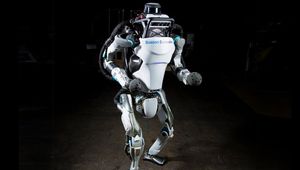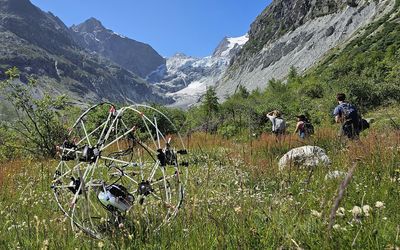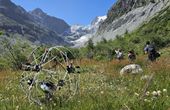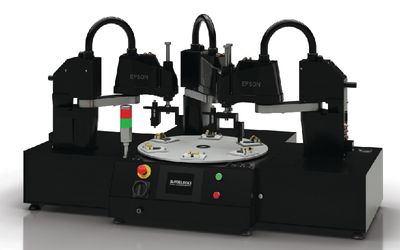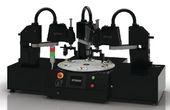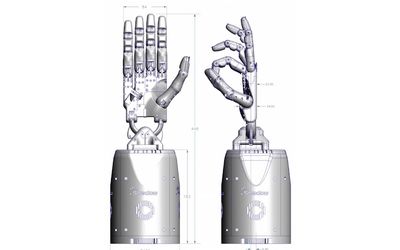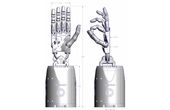ODIN modular robot
A robot based on a deformable lattice and has an extendable set of heterogeneous modules. The Odin robot is a manually reconfigurable robot. The key features of the Odin robot is that it is extendable and it is based on a deformable lattice. The goal of the project is to develop into a robotic set of building blocks which can be brought to unknown environments and configured within a reasonable amount of time to solve a task that could not have been prepared for in advance. The system is based on a hierarchy of modules. Individually, the modules on the lowest hierarchical level are very simple. By combining these simple heterogeneous modules, their functionality adds up to create a more sophisticated robot.
Technical Specifications
| CCP Joint | |
| Diameter | 50 |
| Max. # connected links | 12 |
| Weight | 36 |
| Flexible connector | |
| Max. angle of rotation from ball-jointcentre | 23 |
| Diameter | 35 |
| Distance from centre of rotation to body | 25 |
| Weight (without PCB) | 35 |
| Telescoping body | |
| Diameter | 35 |
| Min. length | 60 |
| Max. length | 132 |
| Max. speed | 50 |
| Strength | 17.2 |
| Weight | 84 |
Overview
The Odin robot is a manually reconfigurable robot. The key features of the Odin robot is that it is extendable and it is based on a deformable lattice.
The goal of the project is to develop into a robotic set of building blocks which can be brought to unknown environments and configured within a reasonable amount of time to solve a task that could not have been prepared for in advance.
The system is based on a hierarchy of modules. Individually, the modules on the lowest
hierarchical level are very simple. By combining these simple heterogeneous modules, their functionality adds up to create a more sophisticated robot.
The low-level modules can be divided into four basic categories based on their functionality:
- Structure module – passive module which adds struc-
tural features. - Actuated module – active module which enables the
robot to perform locomotion and manipulation. - Sensor module – provides sensory inputs about the
environment. - Power module – provides energy to the robot
Design
Odin has an extendable set of heterogeneous modules and is based on a deformable lattice. Also, the modules were divided into four different categories depending on their functionality.
The Odin robot is based on a link-and-joint structure, where the joint connects the links in a specified lattice. The joint is a mechanical part in itself, however, the link consist of two different parts, a body and two connectors, one at each end of the body. For this reason, the mechanical design of the Odin robot can be divided into three basic parts: Joints, connectors, and bodies.
Joint
The joint module specifies the lattice in which the robot can be configured and it is the most important structural module. The joint enables the robot to be configured in a CCP structure. The CCP structure was chosen because of its high stability and strength due to its triangular substructures. It is also known to be the most dense packing of spheres. It consists of 12 female connection slots. Each connection slot is six redundant, which means that a link can be connected in six different orientations. This may come in handy if the link has an actuator or a sensor that operates around a specific axis perpendicular to the link, e.g. bending.
Connector - Flexible
The links are connected to the surface of the joint and developed a flexible connector.
The flexible connector has a ball-and-socket joint with a centre of rotation on the surface of the joint. Around the ball-and-socket joint is placed a spring which sets
the springiness of the connector.
The socket fits into the six-redundant connection slot of the joint and holds four spring contacts to create electrical connections. It places the ball-stud with its centre on the
surface of the joint, exactly 25mm from the centre of the joint. The ball is locked in place by a spring around the ball-stud. The spring also provides the springiness of the
connector, not only around the ball’s centre of rotation, but also around the vertical axis of the connector. Four extra flexible wires (not illustrated) passes through the ball-stud
from the spring contacts to the control PCB inside the body mount. The socket is machined in POM (Polyacetal) and the key and ball-lock is machined in aluminum. The spring and the ball-stud are modified of-the-shelf products. Finally the mount is produced using FDM.
Body - Telescoping
The body part of the link provides the functionality of the Odin modular robot. By changing the body, any functionality can be put into a link. The joint is a structural module, but the link can be any type of module. A link can be a structural module, e.g. a rigid rod filling out the lattice, or a spring adding interesting structural features. A link can also be an actuated module, e.g. a linear or a bending actuator. A GPS link providing knowledge about the robot’s location or a camera module adding vision to the robot are examples of sensor modules. A link can hold power sources such as batteries, solar energy panels or maybe even fuel cells. The body enables the robot to be extended with a large variety of functionalities.
Integrated electronics
The Odin robot is a fully heterogeneous modular robot, therefor the electronics in the modules are also different. The joint provides power sharing and a terminated RS-
484 communication bus between all links connected to the joint. Each link has two PCBs with electronics, a general and a specific board.
The general board is placed in the connector at one end of the link, and the specific board in the other connector at the other end of the link. The general board is designed with a microcontroller and an interface to connect specific electronics. The interface includes power, communication and 8 digital input/output lines which can be multiplexed with up to 4 PWM signals, an SPI bus or 4 analog input lines. The specific board is designed to hold the specific electronics needed to make a specific link functional and controllable by the microcontroller on the general board.
The telescoping link module has a controller for a brushless-DC-motor and power electronics to provide the current needed to drive the motor. Odin has a hybrid communication system which provides both local and global communication between the modules in the modular robot. By means of software the links can choose to communicate locally through each joint independently or to connect the communication busses of both joints together and create a global bus. This
means that the usres can control the organization of the communication network. A pure locally-connected system or a pure globally-connected system can be created, or a
hybrid system with both local and global communication can be set up.
References
This paper describes the electronics and communication system of Odin. Evaluate the layout of the electronics, not its electrical performance.
Describes the design and implementation of a cubic closed-packed (CCP) joint module, a telescoping link, and a flexible connection mechanism. Discusses future work and final conclusion.
Introduces the hybrid communication approach which describes the requirements, design and implementation details of the communication system. Presents Odin and continues with analyses performance based on transfer rates: in general for any hybrid communication system and specifically for Odin. Valida





















